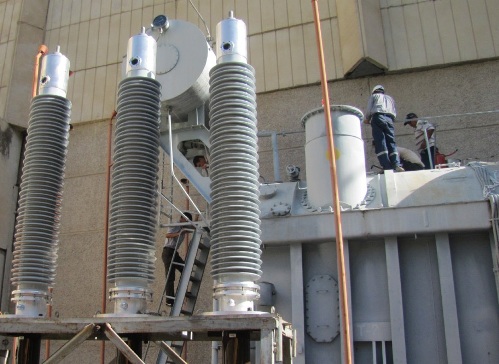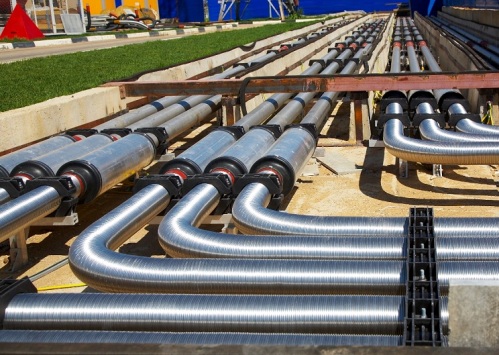RIP insulation and its use
RIP stands for Epoxy Impregnated Crepe Paper. The abbreviation RIP stands for resin-impregnated paper. Crepe paper, on the other hand, is paper with a surface characterized by the presence of small folds on it.
So, RIP is a rigid insulation material made from vacuum-dried crepe paper impregnated with epoxy resin. Such insulation is successfully used in high and medium voltage electrical installations.

Technologically solid RIP insulation is made as follows. Electrical paper, vacuum-impregnated with a special epoxy compound, is wound on a copper or aluminum wire. It turns out a kind of paper skeleton. When this skeleton is wound, leveling plates are placed in it to equalize the electric field. Thanks to vacuum impregnation, gas bubbles are completely excluded from the core, resulting in insulation with high insulating properties. This is RIP isolation.
The same high-voltage bushings based on RIP insulation differ in addition to electrical resistance and excellent fire resistance, which eliminates the risk of fire.Acting as a plug on the tank of a power transformer filled with transformer oil, at the time of failure, such a high voltage bushing will make it difficult for oxygen to enter the transformer tank and the transformer oil will not ignite.
Many modern high-voltage equipment are strategically important, which is why the bushings installed on them often have precisely robust RIP insulation, which provides high mechanical and thermal resistance, environmental friendliness, low level of partial discharges, fire and explosion safety. In addition, solid insulation makes it possible to completely eliminate losses in the transmission of electrical energy, which is important in the growing deficit (according to experts, its level may reach 2750 gigawatts per hour by 2020).
Historical stages of the implementation of RIP insulation
The history of RIP insulation began in 1958, when the Swiss company MGC Moser-Glaser, founded in 1914, received a patent for its invention. The technology is the basis of the device of phase-insulated conductors with cast insulation, the first of which were supplied to Australia in the early 1970s and are still in operation there.
Today, transformer bushings are produced using the same RIP technology. Previously, in Russia and the CIS, the insulation material for transformer bushings was oil barrier insulation throughout — cylindrical cardboard partitions, with foil electrodes attached to them for electric field regulation, separated by an oil filling. This solution (oil-barrier bushings) was used until 1965, but the bushings were very heavy, cumbersome and did not differ in long-term electrical strength.
The most popular internal sleeve insulation today is still oil paper insulation, in which, wound on a conductive tube, the paper core is impregnated with insulating oil. There are leveling plates inside the frame to adjust the electric field. Because such a design features high long-term and short-term electrical strength, it is still used in high-voltage bushings, as it has been for decades.
However, along with the high electrical insulating properties of paper-oil insulation, such a design has a drawback: when the insulation breaks down, the wires simply explode and porcelain fragments fly tens of meters away, and sometimes because of this, fires occur on transformers.
A blown bushing with high tension means a leak transformer oil from the transformer and oil breaker tank which becomes a threat to the environment ecology. Nevertheless, subject to technology and strict quality control of the components, the dielectric characteristics of this type of insulation are such that they can be used in bushings of all voltage classes.
In 1972, Russia began producing 110 kV high-voltage bushings with RBP insulation (resin stands, restricted paper)-paper bonded with epoxy resin. In general, bushings with internal RBP insulation of two types are produced: transformer bushings 110 kV and rated current 800 A and breaker bushings for 35 kV.
The fire safety of equipment with oil increased, but the electrical insulation properties turned out to be worse than those of the same paper-oil insulation. As a result, the main type of bushings in power systems were still paper and oil insulated bushings.Nevertheless, in Russia, there is a trend to start removing high-voltage bushings with RBP and oil paper insulation and replacing them with solid RIP bushings.
Advantages of RIP isolation
Since RIP insulation paper is impregnated with epoxy resin in vacuum, gas inclusions are completely eliminated, resulting in a reduction in the level of partial discharges (maximum 5 pC under two-phase voltage conditions) and a reduction in dielectric losses (tangential from 0, 25 to 0.45%). In terms of thermal and mechanical resistance of RIP insulation, these qualities are very high.

High voltage bushings do not need special maintenance throughout the service life, it is enough only to clean the outside of the porcelain when it gets dirty and to measure it every six years dielectric loss tangent and electrical capacity. The service life of bushings with RIP insulation is more than 40 years.
Today, RIP insulation seems to be the best option for high voltage bushing internal insulation, it is safer than paper and oil insulation and has the best qualities of solid RBP insulation, while the voltage class has increased to 500 kV. Such insulation is widely used today in the production of better quality transformer bushings for voltages up to 500 kV. In addition, RIP insulation remains a relevant material for the production of phase-insulated conductors.
